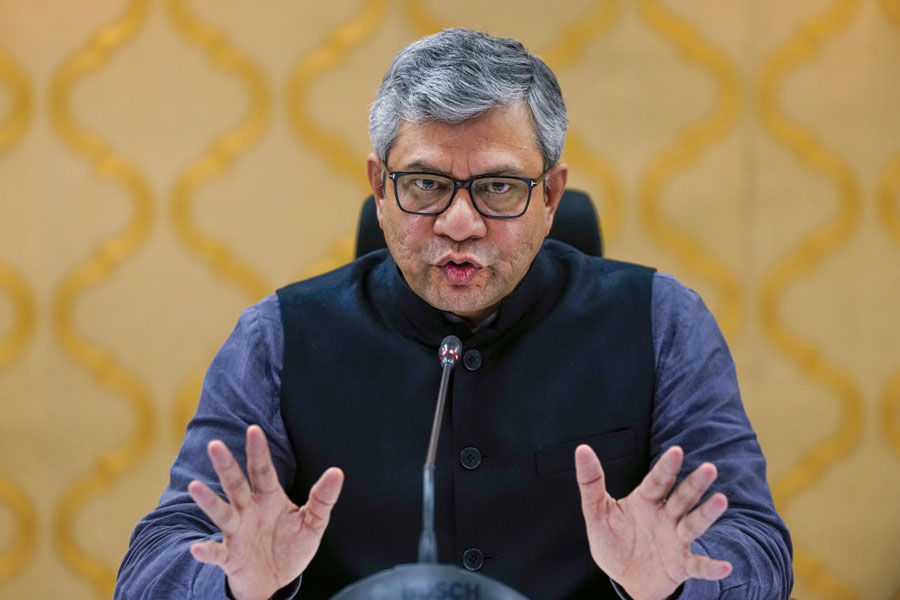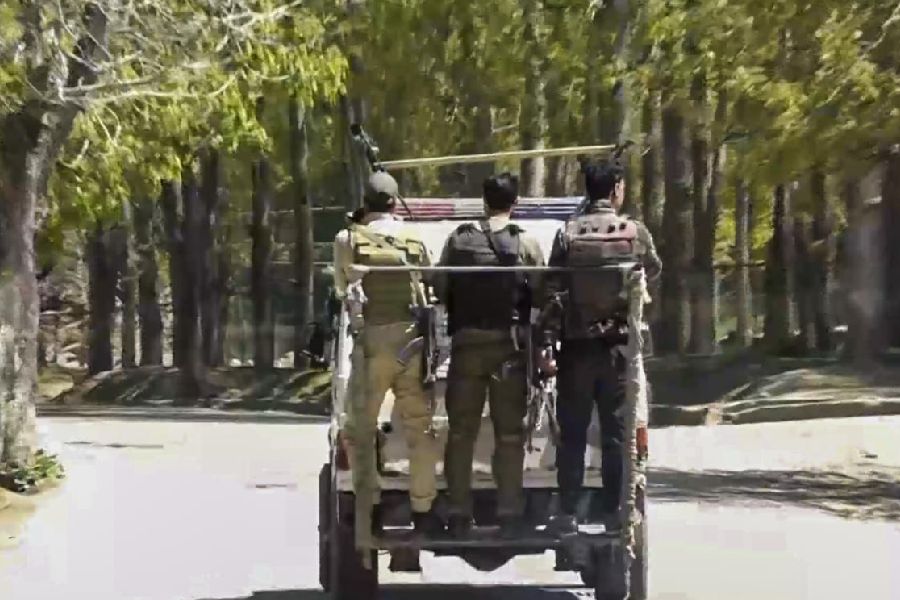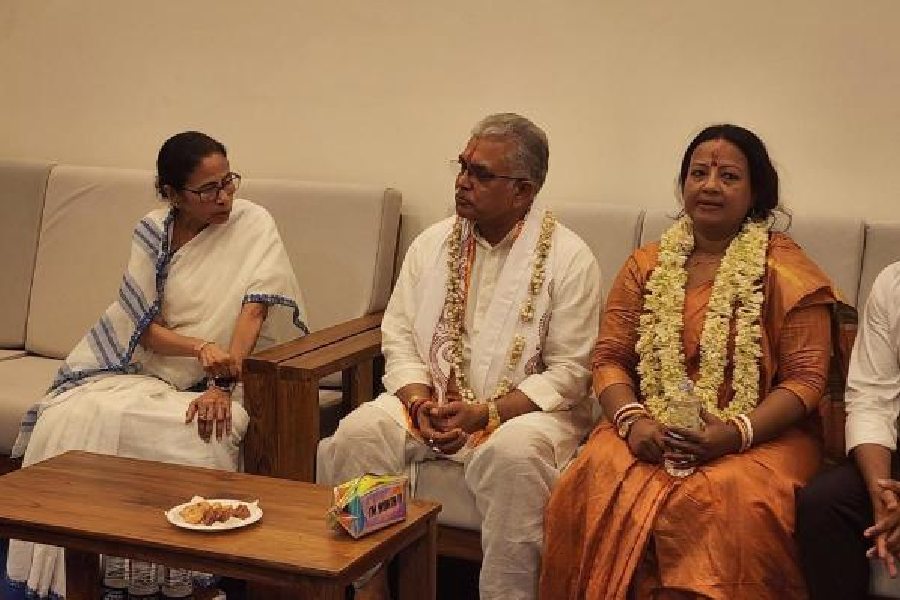|
|
| Then and Now: From sylvan paradise to concrete jungle Photographs: Tapan Das/Mukul Dey |
It was as late as 1990, but grey was still not a colour that described Rabindranath Tagore’s dreamland. Santiniketan, even then, was awash with green. Sunil Gangopadhyay could open his window and gaze out at the golden paddy waving in the breeze for miles around. There were few houses at Phuldanga, a Santiniketan neighbourhood where the writer had just built his home away from home. As Gangopadhyay worked away at his desk, the occasional bell of rickshaws passing by his house was the only distraction. “There was absolutely no mechanical sound. No honking of a car or bus roaring by,” he says. “It was all peace and quiet.”
There is a sense of nostalgia in the writer’s words, for “was” is the operative term there. There was a time when words such as green, peaceful and quiet were the dog-eared adjectives of the ironically-named Santiniketan. People referred to its greenery in the same hushed tones used while describing the muslin of Dhaka, or the mangoes of Lahore. But the muslin is gone, the mangoes have lost their bite and peace is a word that Santiniketan — the abode of peace — recognises no more.
So, 14 years on, Gangopadhyay now looks out of his window to stare at concrete walls all around. In artist Jogen Chowdhury’s garden—where he once listened to birdsong as he worked on his canvas — the chirping of birds is hardly heard. Tagore’s vision of a bucolic Santiniketan — where nature and people live in perfect harmony — lies in tatters as encroachment and unplanned urbanisation swamp its landscape.
Eight decades after Tagore set up Visva Bharati in Santiniketan, efforts are on to save the university town. Some local residents have got together and formed the Santiniketan Anchal Abasik Samity to fight encroachment and illegal construction. The Indian National Trust for Art and Cultural Heritage, too, has pitched in, launching a campaign to keep Santiniketan’s “air and water” free from increased pollution.
And now, worried about its inevitable collapse, 15 notable residents have filed a writ petition with the Calcutta High Court in a bid to “preserve Santiniketan’s rich culture and heritage and its serenity”. The petitioners have taken strong exception to a proposed housing complex on the Khoai, mini canyons of lateritic soil caused by erosion. The Khoai, they said, was a part of Santiniketan’s heritage as its stark natural beauty had inspired not only Tagore but other artists such as Binode Behari Mukhopadhyay and Ramkinkar Baij.
“They are out to kill Santiniketan and its soul by turning it into a hideous concrete jungle for commercial reasons,” says Sushanto Tagore, 76, a petitioner and a descendant of Santiniketan’s first family. “Only the judiciary can save Santiniketan from this systematic destruction,” Tagore stresses.
Santiniketan, a town in Bengal’s Birbhum district about 160 kilometres from Calcutta, grew out of an ashram built by Debendranath Tagore, Rabindranath’s father, in 1863 on a seven-acre plot, where Visva Bharati stands today. In fact, the town got its name from a meditation hall Debendranath had eloquently named Santiniketan. After taking over the ashram from his father, Rabindranath started a school in 1901 with only five students, including his eldest son Rathindranath. Visva Bharati, now a national university with nearly 6,500 students, was born much later, in 1921. And the town—once nestled in trees—started growing around it.
Till the early Eighties, Santiniketan was a sleepy town, drawing mostly students and researchers from different states and abroad. Old-timers insist that when they stood outside Bolpur station, the nearest railhead three kilometres away, and craned their necks, they could see Udayan, Tagore’s home in Santiniketan. Though clearly an apocryphal tale, it is repeated every now and then to emphasise how empty the streets of Santiniketan were in those days.
Today, the narrow stretch between Bolpur station and Santiniketan is clogged with rickshaws, autorickshaws, taxis, buses and lorries. A cloud of dust and fumes swirls over the once-tree lined road, now crowded with shops of all shapes and sizes. Santiniketan stays all-but hidden behind a row of hideous, roadside guest houses and hotels offering “hakka noodles and chilli chicken”.
Santiniketan is convulsing with spasms of change. It’s no longer a quiet university town, but a hot weekend getaway for Calcutta’s boxed-in elite. Lawyers, bureaucrats and police officers — the city’s bold and beautiful — are all headed for Santiniketan where, land, once, came in acres, and one could build a dream bungalow for a fraction of what it would cost in metropolitan Calcutta.
Not surprisingly, anybody who is somebody in Bengal’s capital has a house — or is having one built — in Santiniketan. As Calcutta gets more and more hemmed in from all sides, people are hoping to spend their retired days in “peace and quiet” in the Birbhum town, only a two-and-a-half-hour train ride away from Calcutta.
But “peace and quiet” is at a premium in the town. Things first started changing for the worse in the mid-Eighties when the ballooning population of Bolpur spilled over into Santiniketan. Many of them were poor and unemployed and Santiniketan had both fallow land and employment. Tourism started picking up around this time with the state tourism department focussing its attention on Santiniketan. Fast-food kiosks and souvenir stalls sprouted all over. So did the slums.
“It’s a never-ending battle against the encroachers. We drive them away only to have them back a few days later. We don’t have the means to keep our land cleared,” Visva Bharati vice-chancellor Sujit Basu moans.
Even the mini canyons of Khoai—which Tagore fondly referred to in his autobiographical Jibon-Smriti and Ashramer Roop--Bikash — haven’t been spared. A slum — teeming with shacks made of cloth, jute bags and plastic sheets — has taken over most of the Khoai near Digantapalli, where the proposed housing project is to come up on a nine-acre plot. The rest has, in any case, been lost to a row of two-storeyed houses that have come up in the area. This is not the only blot on Santiniketan’s landscape, though. Locals point to a hooch den housed in a hut a short distance away.
Santiniketan, caught in the throes of a construction frenzy, is bursting at the seams. And what worries its old residents is whether the town can survive the changes. For Santiniketan — neither a panchayat nor a municipality — does not have a drainage, sewerage or a garbage disposal system. In bureaucratic parlance, Santiniketan is known as “no-man’s land”. With scores of new houses coming up, pressures on the land are growing and residents see a civic crisis looming ahead. “I shudder to think what will happen 10 years from now,” Gangopadhyay says.
Some neighbourhoods like Gurupalli are already crammed with houses lying cheek by jowl, while Ratanpalli, where many of the notables live, now looks slummy with shacks strewn around. Santiniketan’s outskirts — areas like Phuldanga — are beginning to look like Calcutta’s Salt Lake. Red-tile bungalows — some with pools and small bridges — are emerging all around.
In neighbouring Prantik — which was nothing but a vast paddy field spiked with trees even a decade ago —apartment houses are springing up, some with billboards inviting prospective buyers. You could now count the trees on your fingertips.
Many residents, ironically, blame Santiniketan’s woes on the Sriniketan Santiniketan Development Authority (SSDA), a government agency created in 1989 to regulate development of the twin towns.
“The SSDA seems to be interested only in housing and commercial complexes, not in an orderly development of Santiniketan into a flourishing academic and cultural centre,” K.G. Subramanyan, the noted muralist and a long-time resident, says. Allowing so many houses without drainage, sewerage and garbage disposal facilities could be the death of Santiniketan, residents argue.
The SSDA, clearly, doesn’t agree. “It was a free-for-all in Santiniketan before the SSDA was created. We have framed building rules and stopped unplanned growth,” SSDA chairman Somnath Chatterjee, also the local MP, says. “We have different height zones and have allowed mostly two-storeyed buildings.”
SSDA argues that its powers are limited. It can sanction building plans, but cannot provide civic amenities or raise taxes, executive officer Ashoke Das says. And like most government agencies, it’s starved for funds.
The private sector steps in when the government is cash-strapped. Workmen are busy at Lahabandh, one of the few remaining wetlands of Santiniketan. The SSDA handed over the 24-acre plot — with a 17-acre pond once full of migratory birds — to a private agency to build an “environment-cum-entertainment” park with various rides, food and souvenir stalls and a mini golf course for tourists. Casting aside protests by the local residents and former Union minister of environment Maneka Gandhi, the SSDA, armed with a court order, is going ahead with the project. “They are trying to create a Nicco Park-type amusement centre in Santiniketan,” says Jogen Chowdhury. “It’s really sad,” he says.
Residents are hoping that the writ petition would put a halt to what they describe as the disfiguring of Santiniketan’s face. “It has to be checked before it’s too late. You can’t just sit back and let them do this to Santiniketan,” Chidananda Dasgupta, the well-known film critic and one of the petitioners, says.
But despite the petitioners’ campaign to stop the assault on Santiniketan, not many believe that the process, once begun, can be reversed, or even halted. “Change is happening everywhere and Santiniketan is no exception,” says Visva Bharati vice-chancellor Basu. “You can’t turn the clock back.”
Even Visva Bharati is moving on. The university, which has long held that no house in Santiniketan should be higher than Tagore’s two-storeyed Udayan — now insists that all new buildings should have foundations for three storeys. “We may lack space in the next 50 years,” Basu says. And as far as the SSDA is concerned, the litigation is just an obstacle in the way of development. “We will carry on with our work even though our money is being wasted on court cases,” Chatterjee says.
The SSDA has its supporters. Sitting in the living room of her duplex house in Sonartaree, a housing complex built by Bengal Peerless last year, Kabita Das — who moved in from Bankura with her daughter, a student at Visva Bharati — defends her right to buy a house in Santiniketan. “If others could build their houses here, why can’t we?” she asks.
The battle — with neither of the two sides willing to let go — promises to be a long one. There is despair among some of its old residents. Bimal Majumdar of Subarnarekha, a popular bookshop near Visva Bharati, is against “what’s happening to” Santiniketan. But the 62-year-old is unsure if the damage can be undone any more. “Even if we succeed in halting the housing project on Khoai, we can’t to stop the encroachment and save Khoai,” he says.
But, as the petition underlines, not everyone is giving up hope. Not just yet, at least. For, the alternative is a requiem —Santiniketan, Rest in Peace.











